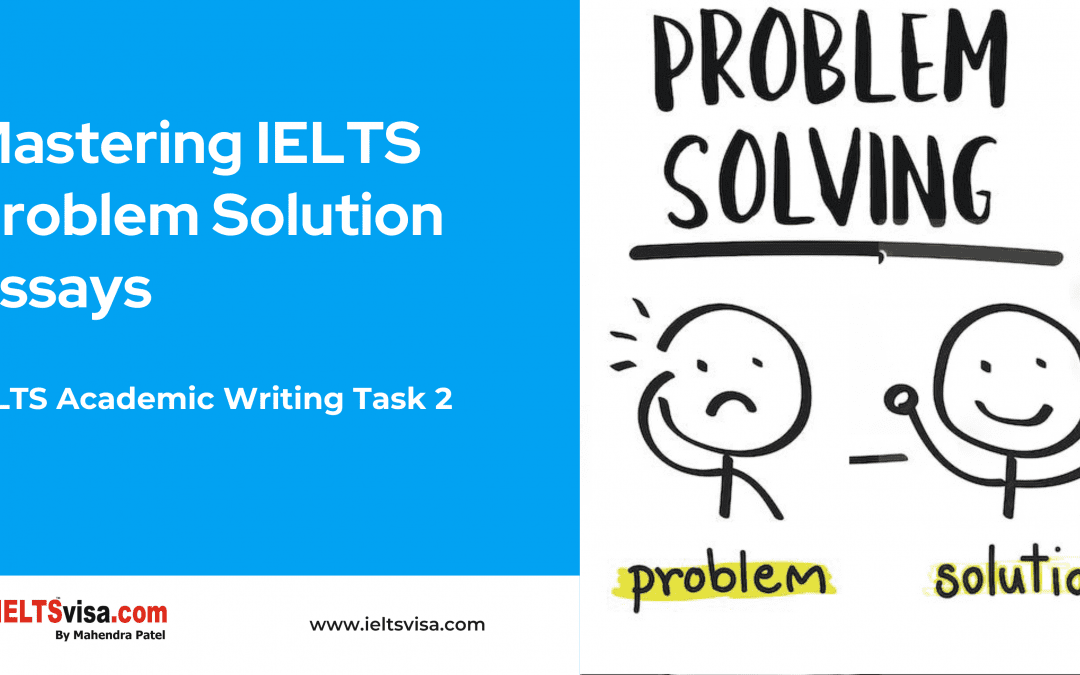Mastering IELTS Problem Solution Essays
Writing problem-solution essays for the IELTS exam can be challenging due to the variety of ways these questions are worded. This book will guide you through effectively analysing, planning, and writing these essays. You will learn how to identify different types of problem-solution essays, avoid common mistakes, and structure your essays for maximum impact.
Chapter 1: Understanding IELTS Problem Solution Essays
Problem solution essays in the IELTS exam can require you to discuss:
- Both the problem (or cause) and the solution
- Only the solution
Types of Problem Solution Essays
- Problem and Solution:
- Example: “More and more wild animals are on the verge of extinction and others are on the endangered list. What are the reasons for this? What can be done to solve this problem?”
- Cause and Solution:
- Example: “In some parts of the world, traditional festivals and celebrations have disappeared. What problems is this causing? What measures could be taken to counter this situation?”
- Just the Solution:
- Example: ” In many developing countries, there is a problem with declining quality of air and water from both industry and construction. What measures could be taken to prevent this?”
Chapter 2: The Question
Understanding how questions are phrased is crucial for correctly identifying the essay type. Here are two typical IELTS problem solution essay questions, each consisting of a statement followed by the question or instruction:
- Wild Animals Extinction:
- “More and more wild animals are on the verge of extinction and others are on the endangered list. What are the reasons for this? What can be done to solve this problem?”
- Disappearing Traditional Festivals:
- “Traditional festivals and celebrations have disappeared in some parts of the world. What problems is this causing? What measures could be taken to counter this situation?”
Examples of Question Phrasing
These are some examples of different ways in which questions can be phrased. The first half of the questions relate to the problem or cause, and the second half to the solution.
- What issues does this cause, and how can they be addressed?
- What are some of the resulting social problems, and how can we deal with them?
- What problems arise from this, and how can they be tackled?
- Why is this? How might it be remedied?
- What are the reasons for this, and how can the situation be improved?
- Why is this happening, and what measures can be taken to tackle this problem?
Solution-Only Questions
Here are a few questions where you only have to write about the solution:
- How can this situation be improved?
- What solutions can you suggest to deal with this problem?
- How can this problem be solved?
- What measures could be taken to prevent this?
Key Words and Synonyms
It’s important that you can recognise the common synonyms, words, and phrases used in problem-solution questions. Here are the keywords and their synonyms used in the questions above:
- Problem – issues, the resulting situation
- Cause – reasons why
- Solution – deal with, addressed, tackled, remedied, improved, measures taken, solved, prevent
Difference Between Problem and Cause
Understanding the difference between a problem and a cause is essential for correctly analysing the question.
- Problem: “I’ve missed the last bus home after visiting my friend for the evening.”
- Cause: “I misread the timetable and thought the bus left at 22.45 when it actually left at 22.35.”
The ‘cause’ is the reason for the ‘problem’. We’ll be looking at question analysis in more detail in a minute.
Chapter 3: Common Mistakes
To write an effective essay, you need to avoid common pitfalls:
- Misunderstanding the Question: Read the question carefully to determine if it asks for problems/causes and solutions or just solutions.
- Lack of Structure: Follow a clear structure in your essay.
- Irrelevant Content: Stay focused on the task given.
- Inadequate Analysis: Fully analyse the problem before suggesting solutions.
- Poor Language Use: Use appropriate vocabulary and grammar.
- Insufficient Practice: Regular practice is essential.
Chapter 4: Essay Structure
Now let’s look at a simple structure you can use to write IELTS problem solution essays. It’s not the only possible structure but it’s the one I recommend because it’s easy to learn and will enable you to quickly plan and write a high-level essay.
Introduction
- Paraphrase the question.
- State 1 key problem/cause and related solution
Main body paragraph 1 – Problem or Cause
- Topic sentence – state the problem or cause
- Explanation – give details explaining the problem or cause
- Example – provide an example
Main body paragraph 2 – Solution
- Topic sentence – state the solution
- Explanation – give further information explaining the solution
- Example – provide an example
Conclusion
- Summarize the key points
This structure will give us a well-balanced essay with four paragraphs.
Chapter 5: One Problem/Cause & Solution or Two?
Most questions will state problems, causes, and solutions in the plural, more than one. However, it is acceptable to write about just one.
This will give you an essay of just over the minimum 250 words. To write about two problems/causes and solutions, you must write between 260 and 300 words, which is a lot to plan and write in the 40 minutes allowed.
It is better to fully develop one problem/cause and solution than to end up with one idea that is missing an explanation or an example because you run out of time.
I will show you the step-by-step essay structure includes one problem and solution, but you can write about two if you feel comfortable doing so.
Chapter 6: How To Plan IELTS Problem Solution Essays
Here’s the question we’re going to be answering in our model essay, followed by the three steps of the planning process:
Question: “More and more wild animals are on the verge of extinction, and others are on the endangered list. What are the reasons for this? What can be done to solve this problem?”
Step 1: Analyse the Question
This is an essential step in planning and will ensure you answer the question fully. It’s quick and easy to do. You need to identify three different types of words:
1. Topic words: These identify the general subject of the question and will be found in the statement part of the question.
Example: “More and more wild animals are on the verge of extinction, and others are on the endangered list.”
2. Other keywords tell you the specific topic you must write about.
Example: “Wild animals, extinction, endangered list.”
3. Instruction words: These tell you the type of IELTS problem solution essay you must write.
Example: “What are the reasons for this? What can be done to solve this problem?”
Step 2: Generate Ideas
The next task is to generate some ideas to write about. There are several different ways to come up with ideas. We’re going to use the ‘friends’ technique’. Imagine that you are chatting with a friend over a cup of coffee, and they ask you this question. What are the first thoughts to come into your head? Plan your essay around these ideas.
Doing this will help you to come up with simple answers in everyday language rather than straining your brain to think of amazing ideas using high-level language, which isn’t necessary.
Here are my ideas:
Reasons:
- Habitat destruction due to deforestation and urbanisation.
- Poaching and illegal wildlife trade.
- Climate change impacts natural habitats.
Solutions:
- Establish and enforce wildlife conservation laws.
- Promote sustainable land use practices.
- Increase public awareness and education programs.
For each reason you think of, immediately write down a possible solution. This will ensure that the problems and solutions you think of are linked.
You don’t need to spend long on this; you only need one or two ideas. I’ve got more ideas here than I need as I spent more time thinking about it than I would in the real exam. I will pick just one reason to develop in the essay and one or two solutions.
My advice on making your selection is to choose ideas you can quickly think of an example to illustrate.
Here are my choices:
- Reason: Habitat destruction due to deforestation.
- Solution: Establish and enforce wildlife conservation laws.
Step 3: Identify Vocabulary
During the planning stage, quickly jot down some vocabulary that comes to mind as you decide which reason and solution you will write about, especially synonyms of keywords. This will save you from having to stop and think of the right language while you’re writing. For example:
- Extinction
- Endangered species
- Biodiversity
- Conservation
- Habitat
- Deforestation
- Urbanization
Chapter 7: How To Write an Introduction
Good introductions to IELTS problem solution essays have a simple 2-part structure:
- Paraphrase the question.
- State 1 fundamental problem/cause and related solution/s (outline sentence)
It should:
- Have 2-3 sentences.
- Be 40-60 words long.
- Take 5 minutes to write.
Paraphrase the Question
Start your introduction by paraphrasing the question.
Question: “More and more wild animals are on the verge of extinction, and others are on the endangered list. What are the reasons for this? What can be done to solve this problem?”
Paraphrased question: “A growing number of wild animals are nearing extinction, and many more are becoming endangered.”
Outline Statement
Next, add an outline statement where you outline the main points you’ll cover in the rest of the essay.
Outline statement: “The primary reason for this is habitat destruction due to deforestation, and the most effective solution is establishing and enforcing wildlife conservation laws.”
Sample Introduction
Let’s combine the two elements of our introduction.
Introduction: “A growing number of wild animals are nearing extinction, and many more are becoming endangered. The primary reason for this is habitat destruction due to deforestation, and the most effective solution is establishing and enforcing wildlife conservation laws.”
This introduction achieves three important functions:
- It shows the examiner that you understand the question.
- It acts as a guide to the examiner as to what your essay is about.
- It also helps to keep you focused and on track as you write.
Chapter 8: How To Write Main Body Paragraphs
Main body paragraphs in IELTS problem solution essays should contain three things:
- Topic sentence – outline the main idea.
- Explanation – explain it and give more detail.
- Example – provide an example.
Main Body Paragraph 1
Main idea: Habitat destruction due to deforestation
Topic sentence: “One of the primary reasons for the decline in wild animal populations is habitat destruction caused by deforestation.”
Next, we must write an explanation sentence that develops the idea.
Explanation sentence: “As forests are cleared to make way for agricultural activities and urban development, animals lose their natural habitats, which are essential for their survival. This leads to decreased biodiversity and pushes many species towards extinction.”
Finally, we add an example to support our main point.
Example sentence: “For instance, the deforestation of the Amazon rainforest has resulted in the loss of habitat for countless species, including jaguars and macaws, placing them on the endangered list.”
Completed paragraph: “One of the primary reasons for the decline in wild animal populations is habitat destruction caused by deforestation. As forests are cleared to make way for agricultural activities and urban development, animals lose their natural habitats, which are essential for their survival. This leads to a decrease in biodiversity and pushes many species towards extinction. For instance, the deforestation of the Amazon rainforest has resulted in the loss of habitat for countless species, including jaguars and macaws, placing them on the endangered list.”
Main Body Paragraph 2
Main idea: Establish and enforce wildlife conservation laws.
Topic sentence: “A crucial solution to combat this issue is establishing and enforcing wildlife conservation laws.”
Now, for the explanation sentence, we expand on this idea.
Explanation sentence: “These laws can help protect endangered species by regulating land use and preventing illegal activities such as poaching and logging. By ensuring that natural habitats are preserved, these laws contribute to the survival of threatened species.”
Finally, an example to support this point.
Example sentence: “For example, the Endangered Species Act in the United States has helped recover numerous species, such as the bald eagle, by providing legal protection and dedicated conservation efforts.”
Completed paragraph: “A crucial solution to combat this issue is establishing and enforcing wildlife conservation laws. These laws can help protect endangered species by regulating land use and preventing illegal activities such as poaching and logging. By ensuring that natural habitats are preserved, these laws contribute to the survival of threatened species. For example, the Endangered Species Act in the United States has successfully helped to recover numerous species, such as the bald eagle, by providing legal protection and dedicated conservation efforts.”
Chapter 9: How To Write a Conclusion
The conclusion summarises the main points in your essay and can generally be done in a single sentence. It should never introduce new ideas.
If you’re below the minimum 250 words after you’ve written your conclusion, you can add a prediction or recommendation statement. Our essay is already over the minimum word limit, so we don’t need this extra sentence.
Writing the Conclusion
The conclusion is the easiest sentence in the essay but one of the most important. A good conclusion will:
- Neatly end the essay
- Link all your ideas together.
- Sum up your argument or opinion.
- Answer the question.
If you achieve this, you’ll improve your score for both task achievement and cohesion and coherence, which make up 50% of the overall marks. Without a conclusion, you’ll score below band 6 for task achievement.
You can start almost any final paragraph of an IELTS problem solution essay with the words:
- “In conclusion”
- or
- “To conclude”
Now, all you need to do is briefly summarise the main ideas in one sentence. Here’s a top tip: Go back and read the introduction because this is also a summary of the essay. It outlines what you are going to write about. To create a good conclusion, you have to paraphrase the introduction.
Sample Conclusion
Introduction: “A growing number of wild animals are nearing extinction, and many more are becoming endangered. The primary reason for this is habitat destruction due to deforestation, and the most effective solution is establishing and enforcing wildlife conservation laws.”
Conclusion: “To conclude, the issue of wild animal extinction is primarily driven by habitat destruction, but this can be mitigated through the implementation and enforcement of wildlife conservation laws.”
Chapter 10: Putting It All Together
Let’s combine all the elements we’ve discussed to complete an essay.
Question:
“More and more wild animals are on the verge of extinction and others are on the endangered list. What are the reasons for this? What can be done to solve this problem?”
Finished IELTS Problem Solution Essay
A growing number of wild animals are nearing extinction, and many more are becoming endangered. The primary reason for this is habitat destruction due to deforestation, and the most effective solution is establishing and enforcing wildlife conservation laws.
One of the primary reasons for the decline in wild animal populations is habitat destruction caused by deforestation. As forests are cleared to make way for agricultural activities and urban development, animals lose their natural habitats, which are essential for their survival. This leads to a decrease in biodiversity and pushes many species towards extinction. For instance, the deforestation of the Amazon rainforest has resulted in the loss of habitat for countless species, including jaguars and macaws, placing them on the endangered list.
A crucial solution to combat this issue is establishing and enforcing wildlife conservation laws. These laws can help protect endangered species by regulating land use and preventing illegal activities such as poaching and logging. By ensuring that natural habitats are preserved, these laws contribute to the survival of threatened species. For example, the Endangered Species Act in the United States has successfully helped to recover numerous species, such as the bald eagle, by providing legal protection and dedicated conservation efforts.
To conclude, the issue of wild animal extinction is primarily driven by habitat destruction, but this can be mitigated through the implementation and enforcement of wildlife conservation laws.
Writing the Second Essay: Disappearing Traditional Festivals
Question:
“In some parts of the world, traditional festivals and celebrations have disappeared or are disappearing. What problems is this causing? What measures could be taken to counter this situation?”
Step 1: Analyse the Question
Topic words: Traditional festivals and celebrations. Other keywords: Disappeared, disappearing. Instruction words: What problems is this causing? What measures could be taken to counter this situation?
Step 2: Generate Ideas
Problems:
- Loss of cultural heritage and identity
- Reduced community cohesion
Measures:
- Promote and support local festivals.
- Integrate cultural education in schools.
Step 3: Identify Vocabulary
- Cultural heritage
- Identity
- Community cohesion
- Local festivals
- Cultural Education
Writing the Introduction
Paraphrase the Question
Question: “In some parts of the world traditional festivals and celebrations have disappeared or are disappearing. What problems is this causing? What measures could be taken to counter this situation?”
Paraphrased question: “Traditional festivals and celebrations are vanishing in certain regions.”
Outline Statement
Outline statement: “This leads to a loss of cultural heritage and community cohesion, but these issues can be addressed by promoting local festivals and integrating cultural education in schools.”
Sample Introduction
Introduction: “Traditional festivals and celebrations are vanishing in certain regions. This leads to a loss of cultural heritage and community cohesion, but these issues can be addressed by promoting local festivals and integrating cultural education in schools.”
Writing Main Body Paragraphs
Main Body Paragraph 1
Main idea: Loss of cultural heritage and community cohesion
Topic sentence: “The disappearance of traditional festivals results in a significant loss of cultural heritage and community cohesion.”
Explanation sentence: “These festivals often play a crucial role in preserving and passing down traditions and customs from generation to generation. Without them, communities lose a sense of identity and belonging, leading to weakened social bonds.”
Example sentence: “For example, the decline of traditional harvest festivals in rural areas has led to a diminished sense of community among residents who no longer have common cultural events to celebrate together.”
Completed paragraph: “The disappearance of traditional festivals results in a significant loss of cultural heritage and community cohesion. These festivals often play a crucial role in preserving and passing down traditions and customs from one generation to the next. Without them, communities lose a sense of identity and belonging, weakening social bonds. For example, the decline of traditional harvest festivals in rural areas has diminished the sense of community among residents who no longer have common cultural events to celebrate together.”
Main Body Paragraph 2
Main idea: Promote and support local festivals and integrate cultural education in schools.
Topic sentence: “To counter this situation, promoting and supporting local festivals and integrating cultural education in schools is essential.”
Explanation sentence: “Governments and local organisations can provide funding and resources to help communities organise and sustain their traditional festivals. Additionally, incorporating cultural education into school curricula can ensure that younger generations understand and appreciate their cultural heritage.”
Example sentence: “For instance, in Japan, the government has successfully revitalised traditional festivals by offering grants and logistical support, while schools include lessons on local traditions, ensuring that cultural practices are kept alive.”
Completed paragraph: “To counter this situation, promoting and supporting local festivals and integrating cultural education in schools is essential. Governments and local organisations can provide funding and resources to help communities organise and sustain their traditional festivals. Additionally, incorporating cultural education into school curricula can ensure that younger generations understand and appreciate their cultural heritage. For instance, in Japan, the government has successfully revitalised traditional festivals by offering grants and logistical support, while schools include lessons on local traditions, ensuring that cultural practices are kept alive.”
Writing the Conclusion
Sample Conclusion
Conclusion: “In conclusion, the disappearance of traditional festivals causes a loss of cultural heritage and community cohesion, but these problems can be mitigated by promoting local festivals and integrating cultural education into school programs.”
Finished IELTS Problem Solution Essay
Traditional festivals and celebrations are vanishing in certain regions. This leads to a loss of cultural heritage and community cohesion, but these issues can be addressed by promoting local festivals and integrating cultural education in schools.
The disappearance of traditional festivals results in a significant loss of cultural heritage and community cohesion. These festivals often play a crucial role in preserving and passing down traditions and customs from one generation to the next. Without them, communities lose a sense of identity and belonging, weakening social bonds. For example, the decline of traditional harvest festivals in rural areas has diminished the sense of community among residents who no longer have common cultural events to celebrate together.
To counter this situation, promoting and supporting local festivals and integrating cultural education in schools is essential. Governments and local organisations can provide funding and resources to help communities organise and sustain their traditional festivals. Additionally, incorporating cultural education into school curricula can ensure that younger generations understand and appreciate their cultural heritage. For instance, in Japan, the government has successfully revitalised traditional festivals by offering grants and logistical support, while schools include lessons on local traditions, ensuring that cultural practices are kept alive.
In conclusion, the disappearance of traditional festivals causes a loss of cultural heritage and community cohesion, but these problems can be mitigated by promoting local festivals and integrating cultural education into school programs.
Following this detailed guide and structure, you’ll be well-prepared to tackle any IELTS problem solution essay effectively and confidently.









